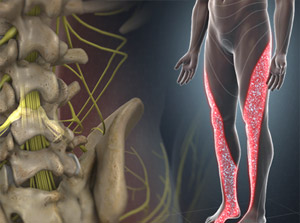Lumbar Radiculopathy
Lumbar refers to the region of your spine from the bottom of your chest down to your tailbone.
Radiculopathy describes a range of symptoms along the course of a particular nerve that is caused by compression of one or more nerves in the spinal column.
Lumbar radiculopathy is a condition that results in irritation or compression of the lumbar nerves, which causes pain, numbness, or weakness of the buttock or leg.
Another common term used for lumbar radiculopathy is called “sciatica”, although sciatica refers to pain caused by irritation of the sciatic nerve which runs in the posterior/back aspect of your leg.
What causes lumbar radiculopathy?
Lumbar radiculopathy may occur when the lumbar spinal nerve roots are irritated and/or compressed by one of many conditions. It may be caused by a bulging disc, stenosis or narrowing of the passageway for your nerves, extra bone formation called osteophytes, or by inflammation along the nerve.
What symptoms may it cause?
Signs of lumbar radiculopathy include:
- Pain in your lower back
- Numbness in your legs, especially when extending your leg
- Problems with your walking and/or your balance
- Feelings of weakness in your legs or feet
- Sensation of your foot dropping
- An electric shock going down your legs
- Weakness around your genital area, causing problems with urination or controlling your bowels
- Weakness and problems during sex

How may it be treated?
There are three levels of treatment that Dr. Webb will use to treat your lumbar radiculopathy. He prefers to exhaust all non-operative treatments before recommending surgery.
Level I: Non-Invasive/Conservative Treatments
- Oral pain medications
- Oral steroid medications
- Oral muscle relaxants
- Formal physical or chiropractic therapy
- Home exercise program
- Activity modification
Level II: Spinal Injections
- Epidural steroid injections
- Nerve root injections
- Outpatient procedures
- Done with x-ray guidance
- 1-3 injections may be needed
Level III: Surgery
Lumbar Minimally Invasive Tubular Retraction (MITR)
This is a procedure where Dr. Webb will make a small incision along your lower back and will work to perform the decompression through a small 18mm tube. This procedure is advantageous because the incision is smaller, muscles are not cut they are moved to the side, and less post operative pain.
Lumbar laminectomy
This is a procedure where Dr. Webb will make a small incision along your lower back and remove bone, ligament, soft tissue, and disc herniation that is compressing your spinal cord/nerves. At times, this procedure does entail fusing your spine with screws and rods if there is any spinal instability or if your spinal compression surgery would involve taking away too much bone. Learn more about laminectomies here.
Anterior lumbar interbody fusion (ALIF)
A fusion procedure that is usually done if there is instability of your spine (in addition to a decompression) by going through your belly. A vascular trained surgeon will assist Dr. Webb in making a small incision in your belly and accessing your spine from the front. The vascular surgeon is used because there are very important vessels right in front of your spine that need to be moved out of the way. Once at the spine, the diseased disc that is pressing on your spinal nerves will be removed and replaced with either a plastic or metal cage to directly and indirectly decompress the spinal cord and nerves. Learn more about ALIFs here.
Extreme lateral interbody fusion (XLIF)
This is a procedure where Dr. Webb will make a small incision on the side of your spine. Once at the spine, the diseased disc will be removed and replaced with either a plastic or metal cage to directly and indirectly decompress the spinal cord and nerves. Learn more about XLIFs here.
Transforaminal lumbar interbody fusion (TLIF)
This is a procedure where Dr. Webb will make a small incision along your lower back and remove the bone, ligament, soft tissue, and disc herniation that is compressing your spinal cord/nerves. Once at the spine, the diseased disc will be removed and replaced with either a plastic or metal cage to directly and indirectly decompress the spinal cord and nerves. Learn more about TLIFs here.
Posterior lumbar interbody fusion (PLIF)
This is a procedure where Dr. Webb will make a small incision along your lower back and remove the bone, ligament, soft tissue, and disc herniation that is compressing your spinal cord/nerves. Once at the spine, the diseased disc will be removed and replaced with either a plastic or metal cage to directly and indirectly decompress the spinal cord and nerves.
Surgical options are used as a last resort if you are unable to live with your pain after a trial of conservative treatments or if you have progressive weakness, bowel or bladder symptoms. Surgical treatment involves relieving pressure off of the compressed nerves and spinal cord. Sometimes, this may require a fusion if there are signs that your spine is unstable. The intricacies of surgery and pros/cons of each surgical option will be discussed with you at your visit with Dr. Webb.
